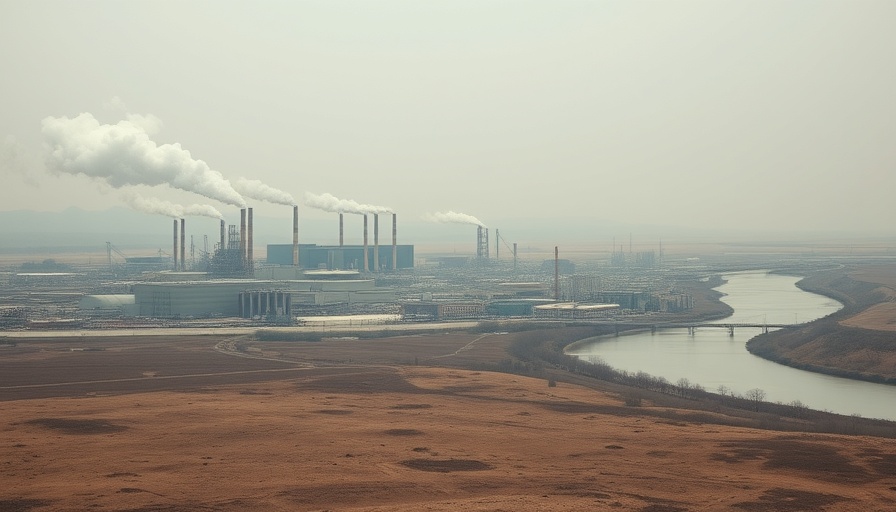
China's Rare Earth Industry: A Double-Edged Sword
China's journey to becoming the world's dominant force in the rare earth metals market illustrates the complexities of industrial growth and environmental responsibility. As China leads the production of these crucial materials, primarily for their applications in advanced technologies like electric vehicles, smartphones, and renewable energy systems, the country faces severe environmental repercussions.
Over the years, in cities like Baotou, where the rare earth industry thrives yet suffers from decades of neglect, we see a stark representation of costs versus gains. Not only did mining and processing operations help boost China’s economy, but they also created an area plagued with pollution and public health challenges. The Weikuang Dam, an artificial lake created from industrial waste, stands testament to this dilemma. The toxic sludge it contains not only deteriorates the local environment but also poses serious risks to the surrounding communities’ health.
The Environmental Toll of Rare Earth Mining
The impacts of rare earth mining extend well beyond industrial pollution. Studies have revealed that regions like Inner Mongolia bear the brunt of hazardous contaminants. When heavy metals such as lead and cadmium seep into the groundwater, they threaten agricultural practices and drinking supplies. Residents living near mining sites report rising rates of illnesses that can be directly tied to these environmental hazards.
This situation worsens as China’s global influence expands. The production of rare earths has historically increased to satisfy global markets while largely ignoring environmental regulations that have curtailed similar activities in other nations. Unlike regions such as Europe and North America, where stringent environmental protections have effectively closed down mining operations due to environmental concerns, China’s lax regulatory framework has allowed these activities to flourish, albeit at a cost to public health and safety.
Lessons from Global Standards
Examining international practices reveals a contrast that raises questions about responsibility and sustainability. Countries like Australia and the United States impose strict environmental regulations, ensuring the industry minimizes its ecological footprint. They have adopted advanced technologies and reclamation techniques to mitigate damage, an approach that contrasts sharply with China's largely unchecked industrial efforts.
As a lesson, the balance between economic dominance and environmental stewardship demonstrates that a proactive approach to mining can yield competitive advantages without sacrificing public health. Transitioning to cleaner, more responsible practices is not only essential for sustainable growth but also for China to maintain its position as a global leader in the rare earth sector.
Future Predictions and Trends for Rare Earths
Looking ahead, the discourse on rare earth production must evolve to include sustainable methods and regulations as central themes. The environmental crises faced by the mining sector may threaten not only public health but also the long-term viability of China’s economic superiority in this industry. As global demand grows—especially for technologies central to combating climate change—China's model will need to incorporate sustainability as a core commitment to avoid becoming an outlier in an increasingly eco-conscious market.
Furthermore, international trade relations may also implicate China's environmental management. Countries concerned with sustainability might hesitate to rely on Chinese rare earths, leading to a diversification of rare earth sources globally. This potential shift could serve as a powerful incentive for China to re-evaluate its environmental policies.
Creating a Sustainable Future
With global awareness of environmental issues on the rise, it is crucial for China to adopt best practices from around the world. This includes creating an industry that prioritizes environmental health alongside economic gains, potentially turning past failings into future achievements. As China is poised to continue leading the rare earth market, the shift toward sustainable practices could redefine its global trade relationships and reflect a commitment to responsible stewardship of natural resources.
Notably, the implications of these changes could ripple through many sectors from technology to automotive manufacturing, highlighting the importance of sustainability as a competitive advantage. That sustainability dialogue is not just an ethical consideration but also a strategic necessity in today's interconnected economy.
In conclusion, while China's dominance in rare earths has been a significant boon for its economy, the accompanying environmental toll raises urgent questions about sustainable practices. Transitioning to green technologies in rare earth production could lead not only to a healthier environment but also ensure long-term economic resilience. It is critical for policymakers and industry leaders to engage in a dialogue about meaningful change that prioritizes public health and environmental stability for generations to come.
 Add Row
Add Row 
 Add
Add 


 Add Row
Add Row 
 Add
Add
Write A Comment